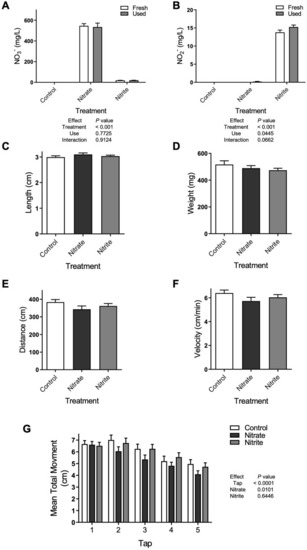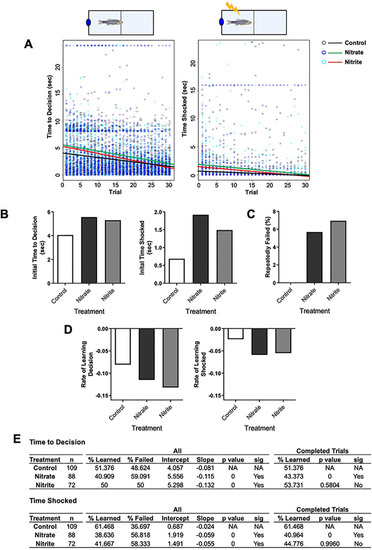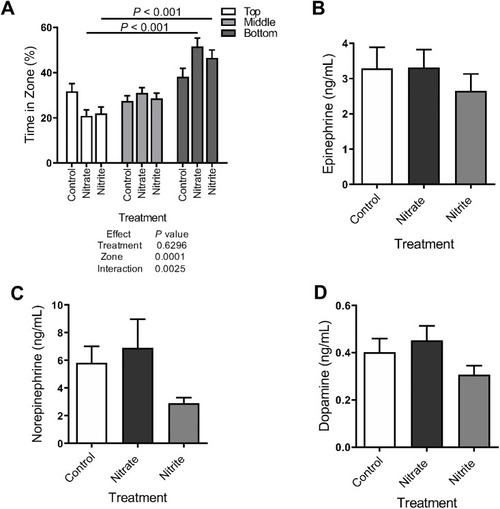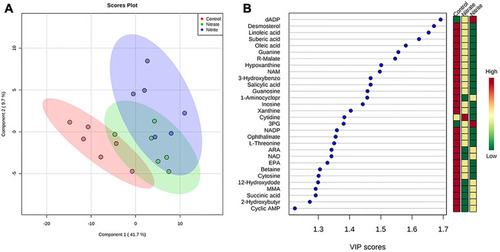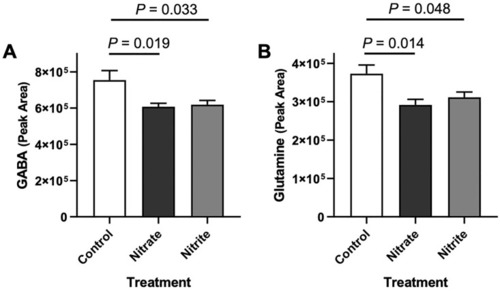- Title
-
Nitrate and nitrite exposure leads to mild anxiogenic-like behavior and alters brain metabolomic profile in zebrafish
- Authors
- García-Jaramillo, M., Beaver, L.M., Truong, L., Axton, E.R., Keller, R.M., Prater, M.C., Magnusson, K.R., Tanguay, R.L., Stevens, J.F., Hord, N.G.
- Source
- Full text @ PLoS One
|
Adult zebrafish were treated with control water, sodium nitrate, or sodium nitrite and (A) nitrate and (B) nitrite concentrations were measured in newly treated fish water (fresh) and water at the end of 42-hour use (used) (n = 7–10). Fish (C) length and (D) weight was measured after 28–31 days of treatment (n = 18–33). At 14–17 days of treatment the (E) distance and (F) velocity zebrafish traveled was quantified in the voluntary swimming assay (n = 39–42) or (G) the response to five sequential acoustic startles (as taps against the fish tank) was quantified (n = 84–90). (A-G) Bars represent the mean ± SEM. |
|
Adult zebrafish were treated with control water, sodium nitrate, or sodium nitrite for 14–17 days when learning and memory were tested in the shuttle box assay (n = 72–109). (A) Time-to-decision and time shocked was recorded for each fish and trial (dots) and linear regression of the data were calculated (lines). As calculated from the linear regression the bars indicate (B) initial periods of time fish spent for the indicated measure and (D) rates of learning as quantified by the slope from the linear regression. (C) Bars indicate the percentage of fish that were removed from the assay because they did not swim to the correct side during eight consecutive trials. (E) Statistical summary of shuttle box results as calculated by an analysis of variance (AOV) followed by a Tukey’s post-test where “All” indicates data from all fish analyzed, while “Completed trials” excludes data from fish that repeatedly failed. |
|
Adult zebrafish were treated with control water, sodium nitrate, or sodium nitrite for 14–17 days. (A) Movement in a novel tank was recorded and the percent of time spent in the bottom, middle and top zones of tank are indicated (n = 83–89). (B-D) Concentrations of hormones were measured in whole fish by ELISA (n = 12). (A-D) Bars represent the mean ± SEM. |
|
The concentration of (A) nitrate or (B) nitrite was measured using targeted LC-MS/MS in control animals or animals treated with (A) unlabeled and 15N-labeled nitrate, or (B) unlabeled and 15N-labeled nitrite. (A-B) Zebrafish brains were collected on day 31 and percent enrichment (in boxes), indicates the relative amount of nitrate or nitrite in the brain that was derived from the treatment. Bars represent the mean concentration ± SEM (n = 6). |
|
Adult zebrafish were treated with control water, sodium nitrate, or sodium nitrite for 31 days and brain metabolites were measured using untargeted LC-MS/MS. (A) Partial least squares discriminant analysis (PLS-DA) scored plot demonstrates spatial clustering and separation between treatment groups when considering all the annotated compounds. (B) PLS-DA variable importance in projection (VIP) graph of the most relevant 30 features (when considering the three treatments). Colored boxes at right indicate the mean relative concentrations of the corresponding metabolite in each treatment group under study. Red color indicates higher abundance, while green color indicates lower abundance. The PLS-DA model display 95% confidence region. Abbreviations: dADP (deoxyadenosine diphosphate), NAM (N-acetyl-L-methionine), 3-Hydroxybenzo (3-Hydroxybenzoic acid), 1-Aminocyclopr (1-Aminocyclopropane-1-carboxylate), 3PG (3-Phosphoglyceric acid), NADP (Nicotinamide adenine dinucleotide phosphate), ARA (Arachidonic acid), NAD (Nicotinamide adenine dinucleotide), EPA (Eicosapentanoic acid), 12-Hydroxydode (12-Hydroxydodecanoic acid), MMA (Methylmalonic acid), 2-Hydroxybutyrate (2-Hydroxybutyric acid). |
|
Adult zebrafish were treated with control water, sodium nitrate, or sodium nitrite for 31 days. Abundance of (A) GABA and (B) glutamine was measured in brain tissue by LC-MS/MS. Bars represent the mean peak area ± SEM (n = 6). |

